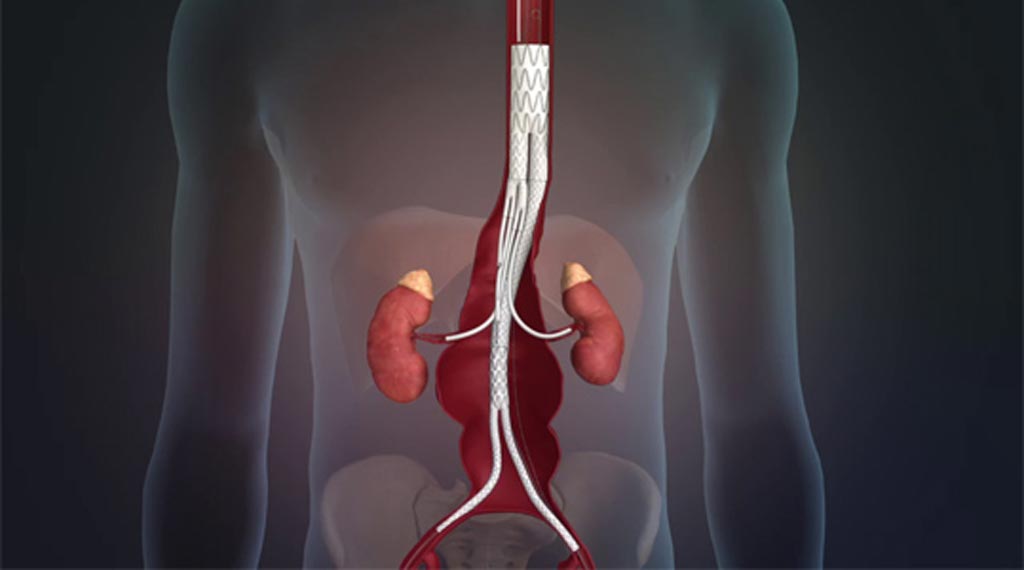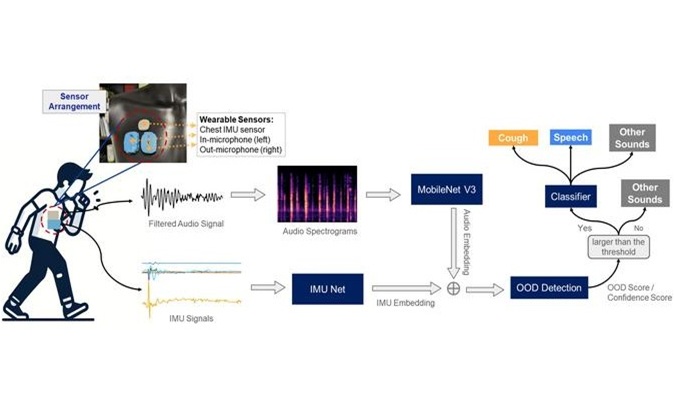Stent Graft System Treats Thoracoabdominal Aortic Aneurysm
|
By HospiMedica International staff writers Posted on 26 Oct 2019 |

Image: The Valiant TAAA Stent Graft System (Photo courtesy of Sanford Health).
A minimally invasive stent graft repairs thoracoabdominal aortic aneurysm (TAAA), a complex condition that causes the aorta to bulge into the abdomen.
The Medtronic (Dublin, Ireland) Valiant TAAA Stent Graft System is comprised of a thoracic bifurcation and visceral manifold graft, which work together to facilitate endovascular stenting of the visceral vessels--the renal, celiac, and superior mesenteric arteries--while maintaining blood flow to the visceral and infrarenal segments. The complexity of the design required the use of computational fluid dynamics simulations in order to create a geometrically correct model of each graft relative to the same aorta coordinates and positioning in the body trunk, as well as the arteries that feed the organs and extend into the legs.
The system is comprised of several sections that interlock into each other proximally. The topmost level includes a thoracic bifurcated graft and a visceral manifold that creates four visceral vessels. Each of the branch vessels is stented individually by bridging stents, which can thereafter accept further descending extensions. An infrarenal graft stent and iliac extensions are also available. Once flow has been secured to each of the involved branches, the open limb of the proximal compartmentalizing graft is extended distally, excluding the diseased segment of vessel.
“Taking the complex and making it simple has long been our goal for the treatment of TAAAs. Working with Medtronic could eventually place our solution in the hands of vascular surgeons around the world to help patients facing a life-threatening condition,” said vascular surgeon Patrick Kelly, MD, of Sanford Health (Sioux Falls, SD, USA), who developed the concept. “We hope that this will have a major impact on the treatment of one of the most challenging disease processes to face our specialty.”
TAAA results from continuous dilation of the descending thoracic aorta, which extends into the abdominal aorta. Degradation of structural proteins such as collagen and elastin, or a defect in their composition, leads to medial degeneration and weakening of the aortic wall. Subsequent dilatation results from hemodynamic forces on the arterial wall, as well as intrinsic changes in the composition of the arterial wall itself, which cause the diameter of the aorta to expand further and increase wall tension, thus creating a vicious cycle.
The Medtronic (Dublin, Ireland) Valiant TAAA Stent Graft System is comprised of a thoracic bifurcation and visceral manifold graft, which work together to facilitate endovascular stenting of the visceral vessels--the renal, celiac, and superior mesenteric arteries--while maintaining blood flow to the visceral and infrarenal segments. The complexity of the design required the use of computational fluid dynamics simulations in order to create a geometrically correct model of each graft relative to the same aorta coordinates and positioning in the body trunk, as well as the arteries that feed the organs and extend into the legs.
The system is comprised of several sections that interlock into each other proximally. The topmost level includes a thoracic bifurcated graft and a visceral manifold that creates four visceral vessels. Each of the branch vessels is stented individually by bridging stents, which can thereafter accept further descending extensions. An infrarenal graft stent and iliac extensions are also available. Once flow has been secured to each of the involved branches, the open limb of the proximal compartmentalizing graft is extended distally, excluding the diseased segment of vessel.
“Taking the complex and making it simple has long been our goal for the treatment of TAAAs. Working with Medtronic could eventually place our solution in the hands of vascular surgeons around the world to help patients facing a life-threatening condition,” said vascular surgeon Patrick Kelly, MD, of Sanford Health (Sioux Falls, SD, USA), who developed the concept. “We hope that this will have a major impact on the treatment of one of the most challenging disease processes to face our specialty.”
TAAA results from continuous dilation of the descending thoracic aorta, which extends into the abdominal aorta. Degradation of structural proteins such as collagen and elastin, or a defect in their composition, leads to medial degeneration and weakening of the aortic wall. Subsequent dilatation results from hemodynamic forces on the arterial wall, as well as intrinsic changes in the composition of the arterial wall itself, which cause the diameter of the aorta to expand further and increase wall tension, thus creating a vicious cycle.
Latest Surgical Techniques News
- Novel Glue Prevents Complications After Breast Cancer Surgery
- Breakthrough Brain Implant Enables Safer and More Precise Drug Delivery
- Bioadhesive Sponge Stops Uncontrolled Internal Bleeding During Surgery
- Revolutionary Nano Bone Material to Accelerate Surgery and Healing
- Superior Orthopedic Implants Combat Infections and Quicken Healing After Surgery
- Laser-Based Technique Eliminates Pancreatic Tumors While Protecting Healthy Tissue
- Surgical Treatment of Severe Carotid Artery Stenosis Benefits Blood-Brain Barrier
- Revolutionary Reusable Duodenoscope Introduces 68-Minute Sterilization
- World's First Transcatheter Smart Implant Monitors and Treats Congestion in Heart Failure
- Hybrid Endoscope Marks Breakthrough in Surgical Visualization
- Robot-Assisted Bronchoscope Diagnoses Tiniest and Hardest to Reach Lung Tumors
- Diamond-Titanium Device Paves Way for Smart Implants that Warn of Disease Progression
- 3D Printable Bio-Active Glass Could Serve as Bone Replacement Material
- Spider-Inspired Magnetic Soft Robots to Perform Minimally Invasive GI Tract Procedures
- Micro Imaging Device Paired with Endoscope Spots Cancers at Earlier Stage
- AI Spine Model Could Reduce Surgical Risks
Channels
Critical Care
view channel
Origami Robots to Deliver Medicine Less Invasively and More Effectively
Delivering medicine to ulcers or other internal sites often requires invasive procedures that can disrupt surrounding tissues and lengthen recovery times. Traditional magnetic actuators used in soft robotics... Read more
Improved Cough-Detection Technology Aids Health Monitoring
Coughing serves as an important biomarker for tracking a variety of conditions and can help monitor the progress of respiratory diseases or predict when someone’s asthma is being exacerbated.... Read morePatient Care
view channel
Revolutionary Automatic IV-Line Flushing Device to Enhance Infusion Care
More than 80% of in-hospital patients receive intravenous (IV) therapy. Every dose of IV medicine delivered in a small volume (<250 mL) infusion bag should be followed by subsequent flushing to ensure... Read more
VR Training Tool Combats Contamination of Portable Medical Equipment
Healthcare-associated infections (HAIs) impact one in every 31 patients, cause nearly 100,000 deaths each year, and cost USD 28.4 billion in direct medical expenses. Notably, up to 75% of these infections... Read more
Portable Biosensor Platform to Reduce Hospital-Acquired Infections
Approximately 4 million patients in the European Union acquire healthcare-associated infections (HAIs) or nosocomial infections each year, with around 37,000 deaths directly resulting from these infections,... Read moreFirst-Of-Its-Kind Portable Germicidal Light Technology Disinfects High-Touch Clinical Surfaces in Seconds
Reducing healthcare-acquired infections (HAIs) remains a pressing issue within global healthcare systems. In the United States alone, 1.7 million patients contract HAIs annually, leading to approximately... Read moreHealth IT
view channel
Printable Molecule-Selective Nanoparticles Enable Mass Production of Wearable Biosensors
The future of medicine is likely to focus on the personalization of healthcare—understanding exactly what an individual requires and delivering the appropriate combination of nutrients, metabolites, and... Read moreBusiness
view channel
Philips and Masimo Partner to Advance Patient Monitoring Measurement Technologies
Royal Philips (Amsterdam, Netherlands) and Masimo (Irvine, California, USA) have renewed their multi-year strategic collaboration, combining Philips’ expertise in patient monitoring with Masimo’s noninvasive... Read more
B. Braun Acquires Digital Microsurgery Company True Digital Surgery
The high-end microsurgery market in neurosurgery, spine, and ENT is undergoing a significant transformation. Traditional analog microscopes are giving way to digital exoscopes, which provide improved visualization,... Read more
CMEF 2025 to Promote Holistic and High-Quality Development of Medical and Health Industry
The 92nd China International Medical Equipment Fair (CMEF 2025) Autumn Exhibition is scheduled to be held from September 26 to 29 at the China Import and Export Fair Complex (Canton Fair Complex) in Guangzhou.... Read more














